My mobile phone rings, on the train to Modena. Another passenger stares at me, and looks a little annoyed. On the iPhone, the name “Massimo Bottura” appears: the chef has found out I’m going to dine at Osteria Francescana. He’s full of adrenalin, as usual, but there’s some extra enthusiasm, and pride: «You’re going to taste my new menu. Almost all of the dishes are new. It will be great. I’m really happy, I think it’s my best tasting menu ever. You must tell me what you think about it afterwards». In theory, this is a bad move: you should never raise expectations. But clearly Bottura is sure of himself.
As for my opinion, I wrote it in the review I noted down right after the meal, for
Guida Identità Golose 2018: “At the end of the meal, we were struck. We walked around Modena, wandering with the help of Google Maps because our mind was far away:
Seafood salad; Soup of clams from North America; Autumn in New York (a superb dish);
Civet, game, snails, herbs and ravioli; Tarte tatin with duck in the style of Mantua; Tirami-Su... Once you arrive in Via Stella, there’s no turning back”. And then: “
Osteria Francescana is a democratic place, because like in the kitchens of many other fine dining restaurants – not all: many – it speaks on different levels. There’s the immediate one, the flavours of the dish and its composition, both perfect. And this could already be enough. And then there’s the concept, the episode that usually refers to multiple events, overlapping influences from around the world, with cosmopolitan escapes and local retreats: you never lose sight of fat Emilia and tasty Italy. And there’s a further dimension, almost every time, which refers to the arts, to culture: the storytelling is fascinating, a confrontation that makes the food nobler, it becomes an extremely refined instrument of expression, and
Bottura has the gift of weaving everything with magic, with the help of a unique brigade, from
Taka to
Davide, and a neat service, «
Massimo is hard to keep up with» says
Beppe Palmieri, but with pride, because even though it’s very hard, he manages, with tenaciousness”.
You need to be tenacious also to reserve a table at Francescana, «the waiting list is almost infinite, 2000 people are waiting». But every effort is largely compensated, if Bottura then offers you such a meal. So here are the photos and captions.
They serve us grissini with extra virgin olive oil, a bread ciabatta made with durum wheat flour, a zoccoletto made with wheat. And the appetizers, paired with a glass of
Champagne Grand Cru Blanc de Blancs Pierre Legras.
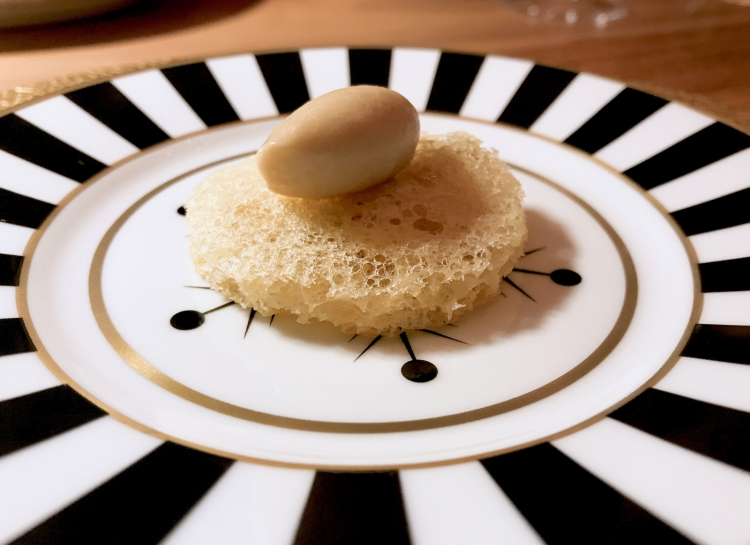
Aula: fried albarelle with carp ice cream. Lovely
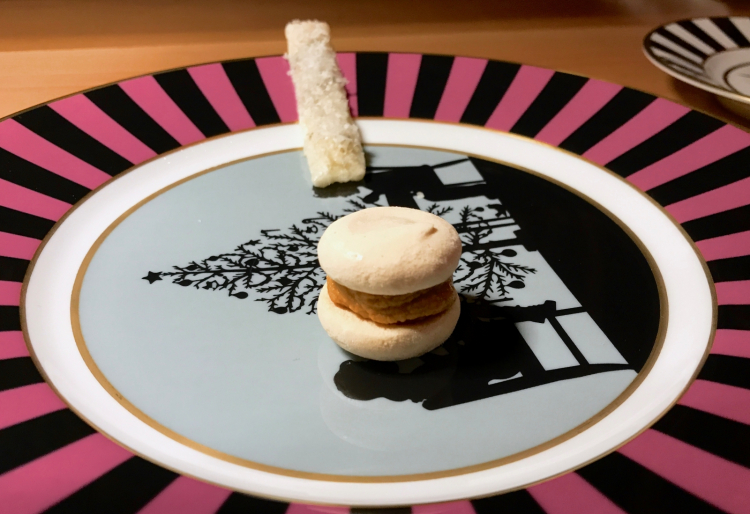
Macaron of rabbit cacciatora and Borlengo with Parmigiano
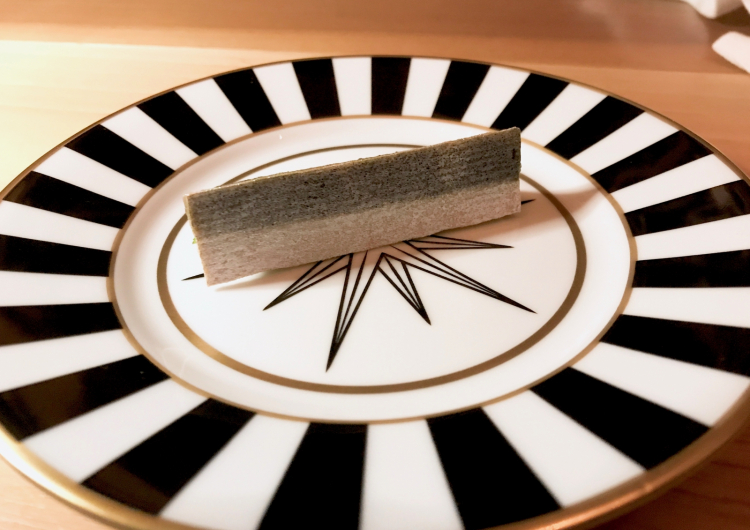
This is not a sardine: bread wafer with cream of eel. A reference to Magritte
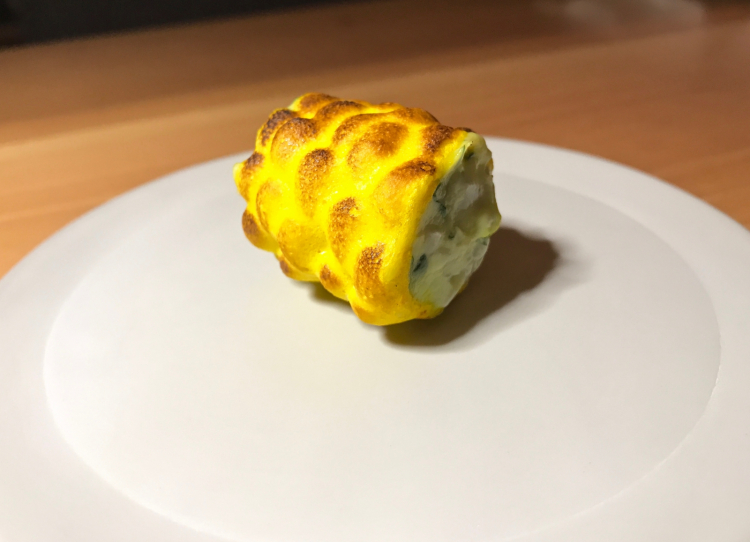
Corn on the cob: a meringue forms a corn on the cob filled with seabass ceviche and guacamole sauce
There’s an abundance of play with the palate, with changes in shape and texture: the
Homage to Ciro Oliva tastes like pizza, including the pleasant burnt aroma; the
Macaron is with rabbit cacciatora,
Corn on the cob has the aromatic acidity of ceviche,
Borlengo the umami of Parmigiano, and so on. Then there’s the first real dish.
Seafood salad is a sumptuous recipe, the evolution of
Caesar Salad in bloom: crispy heart of lettuce, chips of clams, of squids, of calamari, of mussel
impepata... The seafood salad, the way we know it, is not here, but then it is. And it’s very intense.
Palmieri sprays an essence of sea aroma, as if there was a storm, and it’s paired with sakè with yuzu, «almost a limoncello». The texture is incredible, the flavour is very complex, in a constant play with memories and surprises for the taste buds.
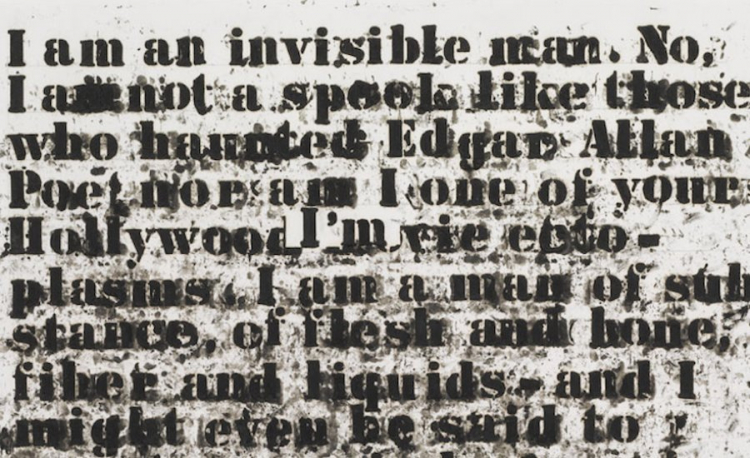
Senza titolo (“I am an invisible man”), Glenn Ligon, 1991
, is almost an evolution of
Homage to Monk, and celebrates another American artist, conceptual artist
Glenn Ligon: black and white, mostly black, with
Burnt written in white.
Bottura takes us to the timeless and spaceless Riviera Romagnola, in front of the grill where they’re roasting sardines, with a few burnt notes. Hence sapidity, smokiness, the spiciness of Mexican jalapeño, iodine.
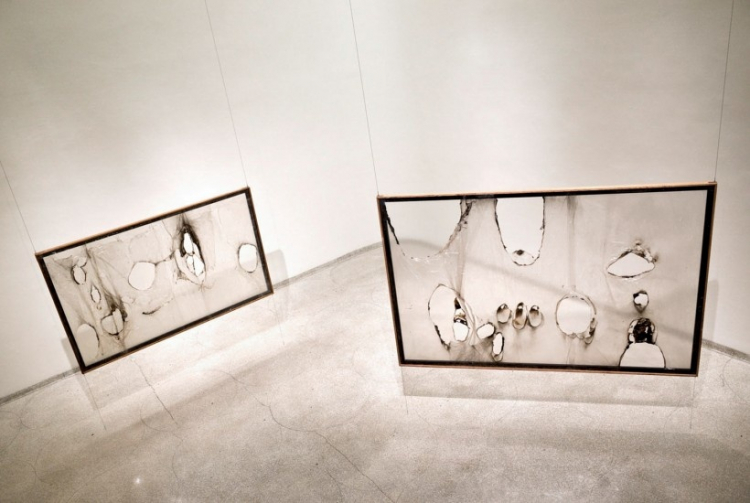
Some of Alberto Burri’s plastic combustions, from an exhibition at the Guggenheim in New York
, the idea is to blend different preparations, a sole fried in flour, one made en papillote, and one baked covered in salt. Then tomatoes, olives, capers, lemon sauce and most of all dehydrated and burnt sea water, and the decisive and “live” moment given by the heat that flits on its thin flakes. It recalls
Alberto Burri and his plastic on which he used a torch.
Bottura’s cuisine is evocative, it winks at you, seduces you. It takes history on its shoulders and then throws it on the plate. A thousand constant madeleines of tastes. And this is why it’s extremely fascinating. It speaks Italian, but with references to the arts, to aesthetics. Thus it touches everyone.
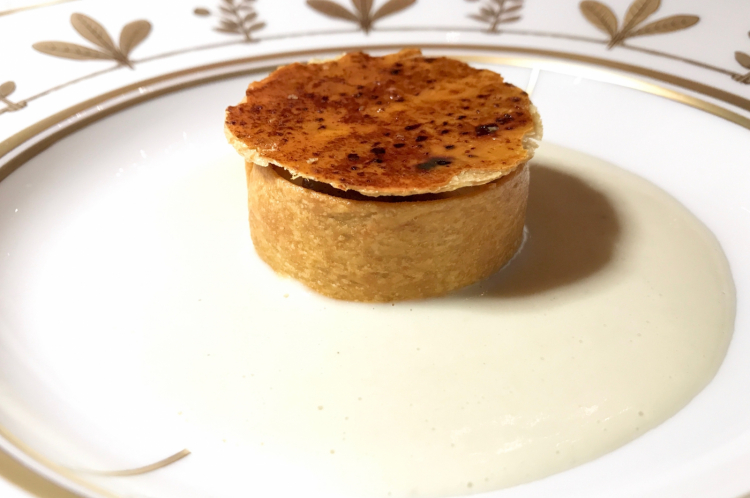
Soup of clams from North America
, a sort of pie dedicated to magpies, «they steal whatever they can find to build their nest, we take seasons and their products and make our delicious nest» says
Palmieri. Hence truffle, onion, cauliflower in vinegar, snails... And U.S.
clam chowder, with a cream of Jerusalem artichoke. It’s a truly delicious dish, «Renaissance, but modern». The "lid" is a blast: it’s a very crispy wafer made with chicken, pigeon and pork skins. It’s paired with a blend of Pinot Gris and Riesling, Alsatian
Rotenberg Premier Cru 2005 by
Marcel Deiss
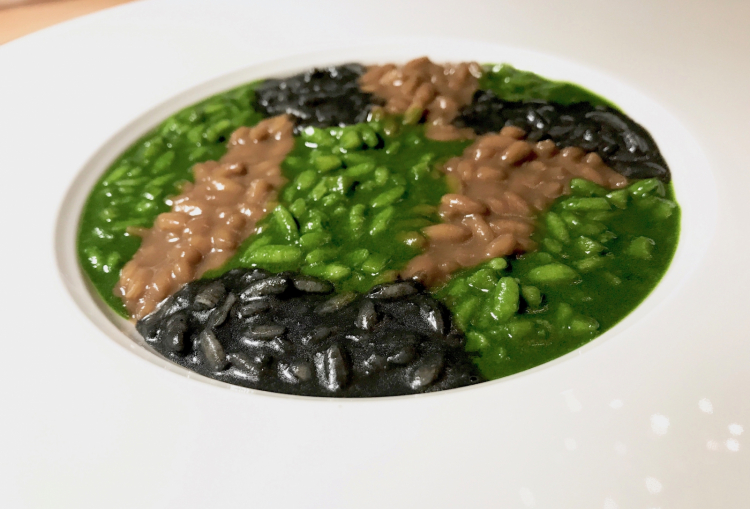
Rice: green on brown on black
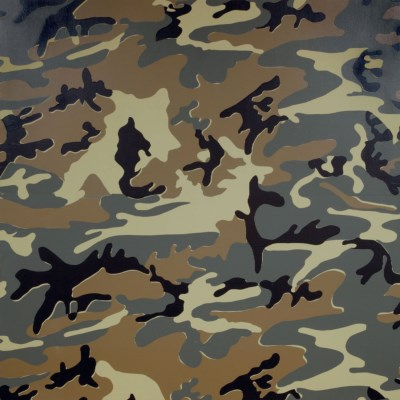
Camouflage, Andy Warhol, 1986
A cocktail arrives: Chartreuse, Tassoni cedrata, soda, gentian, then lavender, geranium... «You’ll see how fresh the scents are». Then the dish,
Rice: green on brown on black, the cereal is neither creamed nor toasted, but cooked in three juices: spinach (green), porcini (brown), squid ink and oyster reduction (black). The aesthetics recall
Andy Warhol.
Autumn in New York is the best dish in our opinion, the one that drew our palate to ecstasy. It’s not new, but like the other ones previously available, it has experienced a constant evolution. It has now reached its perfection, who knows if
Bottura will manage to improve it further. It’s the story of an apple declined in every shape available in the world, just like New York – the Big Apple – embraces every culture. It should deserve a report by itself. Beetroot, apples, potatoes, sour cream and dashi broth; it recalls US Jewish apple pie, Italian campanina apples, Spanish grilled apples and so on. It’s inspired by a song by
Billie Holiday and by the Union Square Greenmarket in New York... A masterpiece of elegance, «it all begins with a broth of potatoes and pork that meets sour cream».
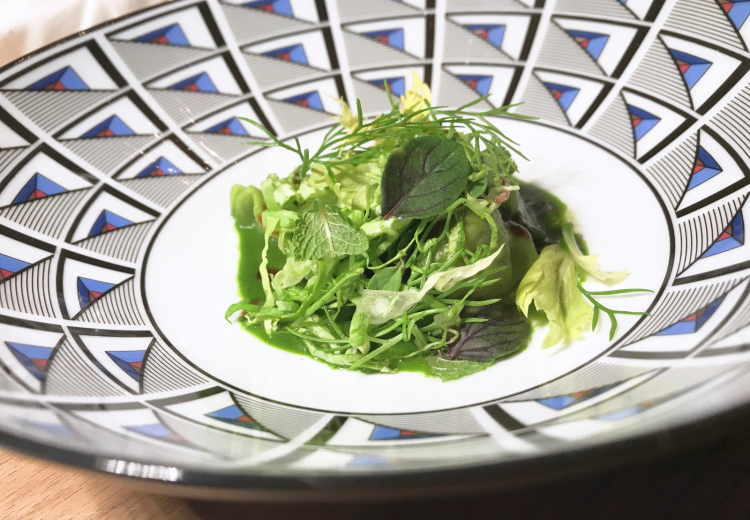
Civet, game, snails, herbs and ravioli
The following dish is also extraordinary,
Civet, game, snails, herbs and ravioli. Is it a salad? A starter? A first course? A main dish? (Maybe) not a dessert.
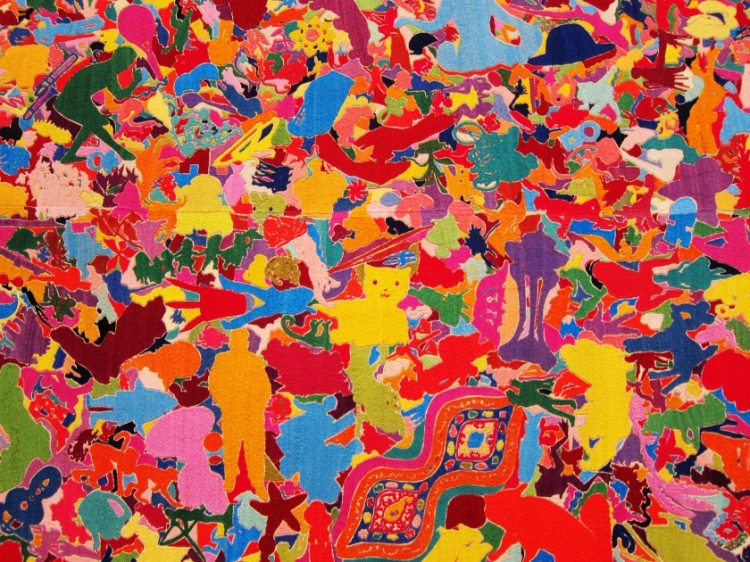
Tutto, detail, Alighiero Boetti, 1988
They serve a glass of
Boca 2009 by
Le Piane, 85% Nebbiolo, 15% Vespolina. It’s paired with
Pigeon camouflage, that is to say a fusion version of the bird, «a colourful assemblage in the style of
Alighiero Boetti» with beetroot, citrus fruits, vegetables and horseradish, also in the shape of sauce and powdered, dehydrated, on the so called leg, which is recreated after the meat is chopped with a knife and fried. The breast is in a foie gras confit. Then come the memories: peach extract with cherry flowers, from Japan; rose extract, from Turkey...
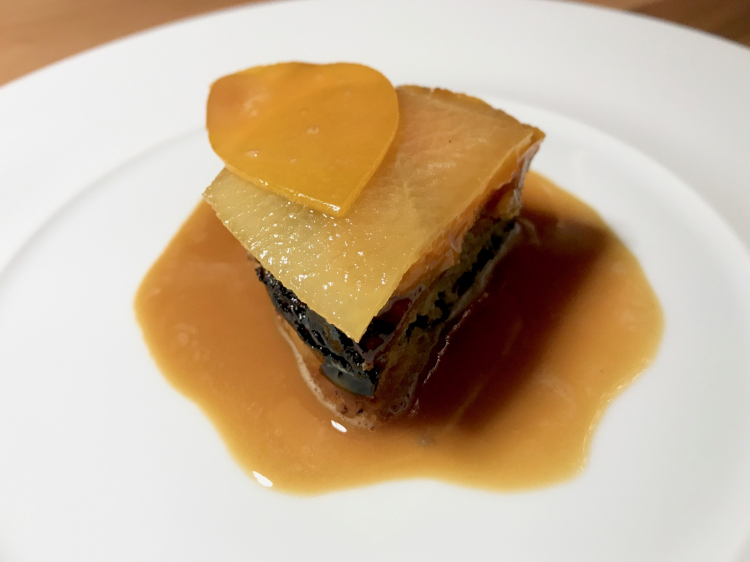
Tarte Tatin with duck in the style of Mantua
is another pillar, from an idea of
Davide Di Fabio. Exceptional. They caramelise the pumpkin, apples and celery and then add Calvados and truffle broth. The '"dough" is made with game, livers, puff pastry, mustard, cream of pumpkin in the style of Mantua, amaretti cookies. On top, pickled vegetables, and a jus of game and truffle broth.
Wine:
Sauternes Castelnau de Suduiraut 2009. Dish:
Game cake, that is to say a cake of game livers, smoked chestnut, rye bread, game jus. This dish creates a bridge between sweet and savoury.
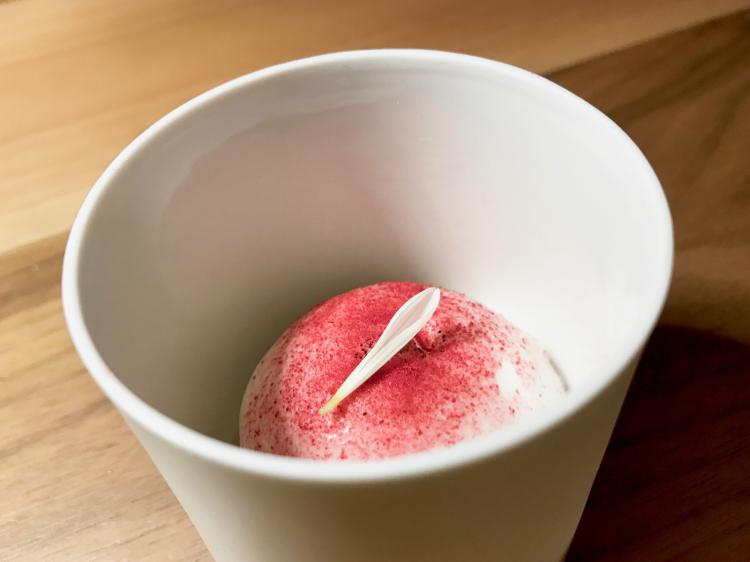
Cherries, amarene, duroni, marasche and dry bread
Time for dessert:
Cherries, amarene, duroni, marasche and dry bread, with a mousse of ricotta and almonds. Fresh and aromatic.
At last, the final cuddles before leaving:
Macaron with hazelnuts, Pralina Camouflage which recreates
Camouflage: a hare in the wood, an iconic dish by the chef from Modena, with chocolate, foie gras, white truffle and powdered Jerusalem artichoke; then
Vignola, where he recreates a cherry with chocolate and juice of marasca cherries; the famous
Croccantino al foie gras in miniature size...
Is a conclusion necessary? Let’s say that Bottura, more than anyone else, continues a swift intellectual as well as gastronomic work. In his crossover between food and art, he makes food noble by raising it to a representation and language of culture; he thus continues Gualtiero Marchesi’s work. The latter didn’t love him that much: perhaps because he was and is the only one who can match up with him.
Translated into English by Slawka G. Scarso